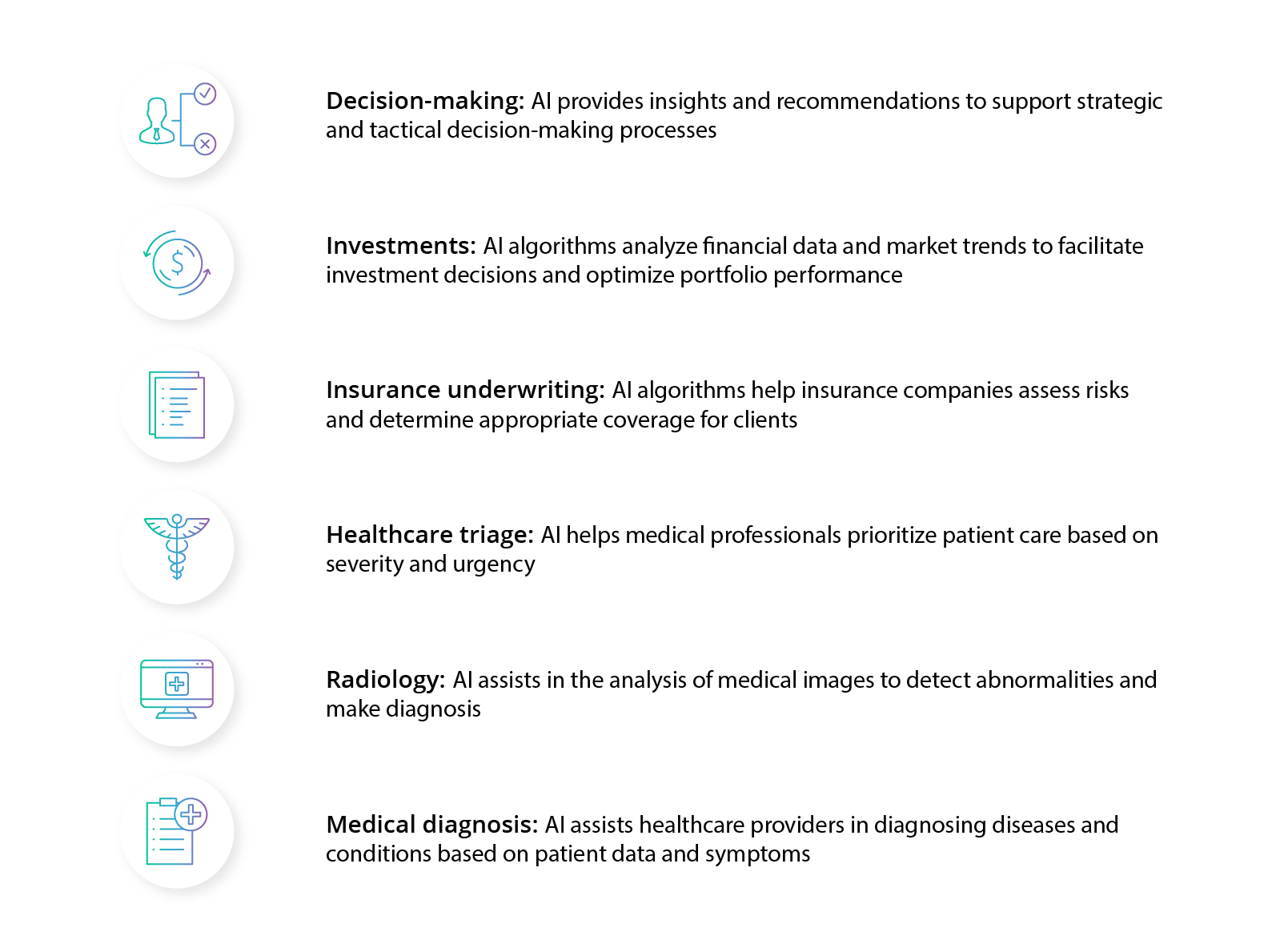According to the Ipsos Global Views on AI 2023, 52% of people reported feeling nervous about AI products—up 13% from 18 months earlier. Apparently, increasing exposure to generative AI and other artificial intelligence is making customers trust AI products less, not more.
So, while demand for AI services and solutions is high, customer confidence in AI is slower to follow. For this reason, before you set out to develop an AI product, make sure there’s a plan in place to build confidence as well.
Addressing customer concerns openly and transparently is crucial to building trust. Understanding how your customers interact with AI is the first step to developing a trustworthy AI product. So, before you start an AI project, read on to explore ways to design trustworthy AI products and tackle bias in AI. We’ll also examine customers’ demand for transparency and explain how we build AI software that alleviates those concerns.
Understanding automation and augmentation
AI use cases typically fall under two broad categories: automation and augmentation. Each type is suited for certain tasks and offers benefits and challenges.
Both methods promise to increase capacity and reduce human error, but the initial investment can be high. Automation can involve high up-front costs and raise concerns about job loss. On the other hand, augmentation—which uses AI to enhance emploees’ capabilities—requires extensive integration and user training.
Let’s take a closer look at these two main ways of using AI:
Automation: AI reducing dependency on human labor
First, let’s define automation in AI. Automation uses AI to perform repetitive, data-driven tasks without human effort. Examples range from AI-driven data analysis tools to automated quality control systems and manufacturing robots.
Benefits of automation:
- Speed and efficiency: Computers handle many tasks faster and without errors.
- Cost savings: Reducing manual labor can cut labor costs significantly.
- Consistency and accuracy: Without human error, output is more consistent.
For example, Intellias uses AI assistance in the development process to speed software delivery to our customers. See how our team used GitHub Copilot to deliver a turnkey healthcare benefits management solution in a short timeframe.
Of course, as AI makes automation easier and more intelligent, there’s an elephant in the room: job displacement. As more tasks become automated, will human workers become obsolete?
Challenges of automation:
- Job displacement: Automation could lead to the loss of jobs that specialize in repetitive tasks
- High initial investment: Implementing automation can cost a lot upfront
- Ongoing upkeep: Automated systems can be complex and require maintenance
Even before GenAI, McKinsey analyzed a huge swath of activities across over 800 occupations to explore which could be easily automated. They found that, across all sectors, about half of workers’ activities were automatable. These activities ranged from physical tasks, like lifting and stacking boxes, to digital tasks, including data collection and processing. In 60% of occupations, about 30% of activities could be automated.
Job displacement is a valid concern that can be addressed with proper planning and upskilling initiatives.
Augmentation: AI enhancing human effort
Augmentation in AI is all about supporting and enhancing human capabilities rather than replacing them entirely. Unlike automation, which aims to take over specific tasks, augmentation acts as a complementary force, amplifying human productivity and fostering innovation. By offloading the heavy lifting of data processing and analysis to intelligent systems, humans can focus on higher-level thinking, creativity, and strategy.
Benefits of augmentation:
- Enhanced decision-making: Data-driven insights improve the quality of decisions.
- Increased productivity: AI helps workers focus on strategic and creative tasks.
- Innovation: Augmentation fosters new ways of working, enhancing human creativity.
Challenges of augmentation:
- Integration: AI-powered products must work with existing systems and processes.
- Training and adoption: Education and buy-in are crucial to success with AI tools.
- Cost of implementation: The implementation of augmentation tools can be costly.
Let’s walk through some notable examples that underscore AI’s potential to augment human capabilities across various sectors:

Blending automation and augmentation in business strategy
Automation? Augmentation? It’s not an either-or decision. Both ways of using AI can coexist in a business strategy. However, the choice of which method to use and when can be a friction point, which can sow distrust.
According to the 2024 Global Survey from Workday, 42% of employees say their company lacks a clear understanding of which systems need human intervention and which can be fully automated. “When it comes to organizations adopting and deploying AI responsibly, there is a lack of trust at all levels of the workforce, particularly from employees,” says the report.
By understanding and addressing the benefits and challenges your customers face, you can develop AI products that enhance human capabilities and foster trust among users. If used thoughtfully, both automation and augmentation can maximize productivity and innovation while maintaining transparency and accountability.
Building trustworthy AI products
Several factors influence trust in AI, including transparency, reliability, ethical considerations, and user engagement. As such, building AI products that customers trust requires a multifaceted approach. Here are some ways to address these factors step by step while you make an AI product.
Trust in AI by Design
Trust by design means developing an AI in a way that helps users feel safe and confident about using it. It’s about being clear on how your AI product makes decisions and making sure it treats everyone fairly. Let’s explore methods to build AI software that people can trust:
Communicate performance metrics
One of the most effective ways to build trust is by communicating the performance metrics of your AI systems. You can demonstrate your AI’s effectiveness with:
- Outcome metrics: Measure AI impact against business goals such as increased sales or reduced costs
- Output metrics: Measure AI performance in terms of accuracy, speed, and reliability
Present these metrics clearly, ensuring and explaining their relevance to users, and update them consistently.
Illustrate confidence levels
Quantifying the confidence levels of AI decisions helps users understand how reliable a system is. Display confidence scores—the likelihood of the AI’s recommendation or prediction being accurate—alongside AI decisions and set clear thresholds for these scores. These confidence metrics will help manage user expectations and build trust in the AI’s output.
Provide explanations for AI reasoning
Understanding is vital to trust. Users need to know how and why artificial intelligence makes certain decisions. Developing interactive tools that let users explore AI decision-making processes can significantly enhance trust. Use interpretable models and provide simplified explanations of complex AI processes.
Acknowledge limitations
Sometimes, your AI will not have the correct answer. Set expectations by acknowledging your AI model’s limitations from the outset.
Communicate openly about what the AI can and cannot do, establish mechanisms for error reporting, and show a commitment to ongoing improvement based on user feedback and new data. Customers will appreciate your integrity, fostering trust in your AI product.
Keep a human-in-the-Loop
Integrating human oversight is a great way to enhance trust. If your AI is making critical decisions, make sure humans review them.
Implement stages where experts review AI model outputs and develop systems that facilitate collaboration between AI and human workers. Keeping human eyes on models throughout the process helps ensure that AI decisions align with humans’ values and expectations.
Define accountability
Accountability is essential for trust. Clearly define who is responsible for the AI’s actions and decisions, adhering to ethical guidelines, and ensuring compliance. Accountability demonstrates a commitment to responsible AI use and builds user trust.
Support user onboarding
Any time you’re creating AI products, product development is only the beginning.
Designing effective user onboarding can raise trust in your AI products. Provide comprehensive training materials and sessions for users to establish robust support systems for navigating and using AI-powered products effectively. Consider creating channels for users to provide feedback and suggestions.
Understanding and addressing bias in AI models
Bias in AI is a big problem.

Let’s explore where these biases come from, how they can affect us, and what we can do to make AI more fair for everyone. Bypassing the biases will help you create a better AI product, solve the business challenges of early product deployment, and reduce associated risks.
Bias can lead to unfair decisions or cause harm, so before you make an AI product, be very mindful to avoid these issues. As you review the examples below, imagine how these biases could affect outcomes in high-stakes real-world situations such as AI-powered healthcare triage, judicial sentencing, or self-driving automobile collision avoidance.
Algorithmic bias
It’s easy to think of AI algorithms as objective tools. However, as people make them, they can inadvertently amplify human biases. These biases can manifest in various ways, often impacting marginalized groups disproportionately.
Encouraging diversity among team members developing AI systems is a powerful way to bring a variety of perspectives into the development process. Diversity reduces the risk of individual biases affecting the model you’re building.
Bias audits and reviews are another important tool for anyone building AI software. Make a habit of conducting regular bias checks to identify and mitigate biases in the algorithms and outputs.
Historical bias
Data reflects the biases that exist(ed) in society when data is/was collected. In other words, if you create an AI system trained on outdated data, the output may reflect outdated perspectives.
For example, consider an AI trained to screen job applicants. Suppose it is trained on decades of data from a specific company’s domain that had a record of favoring certain demographics or preferring men in managerial roles and women in administrative roles. In that case, the output would reflect these biases.
This AI model may recommend candidates based more on demographics that fit the profile of historical data instead of focusing on their education, skills, and professional experience.
- Balanced datasets: Ensure that the training data is balanced and representative of all demographic groups to avoid perpetuating historical biases.
- Bias audits: Regularly audit the training data and the AI model’s outputs to detect and correct any biases that reflect historical inequalities.
Representation bias
Representation bias arises when the data used to train an AI system doesn’t fully capture the diversity of the group it’s meant to serve. This often leads to certain segments of the population being under-represented.
For example, if a speech recognition system is mostly trained on voice data from native English speakers, it might struggle to recognize accents or dialects from non-native speakers accurately.
Another example is a facial recognition system trained predominantly with images of men, which may perform less accurately in identifying women, particularly if it has not been exposed to a balanced gender dataset during its training phase.
Steps to mitigate representation biases:
- Inclusive data collection: Ensure the training data includes diverse and representative samples from all relevant demographics
- Continuous data updates: Regularly update training datasets to reflect current and diverse real-world conditions
Measurement bias
Measurement bias refers to inaccuracies that occur when the metrics or indicators chosen to represent a concept do not effectively capture it or when these measurements vary inconsistently across different groups. This bias can lead to misleading conclusions.
An example would be using body mass index (BMI) as a proxy for an individual’s health or fitness level. BMI might not accurately reflect a person’s overall health as a single factor. It doesn’t distinguish between muscle and fat mass or account for distribution of fat or muscle. If a model focuses on BMI over other metrics, athletes or individuals with high muscle mass might be incorrectly classified as overweight or obese.
Steps to mitigate measurement biases:
- Multi-factor evaluation: Use multiple indicators to measure concepts rather than relying on a single metric
- Contextual analysis: Analyze metrics within the context of their application to understand how different groups might be affected differently and adjust measurements accordingly
Learning bias
Learning bias is the tendency of machine learning models to develop certain biases based on the training data and learning algorithms used during development. Learning bias leads to performance discrepancies among different demographic groups. This is often a result of a model’s cost function optimizing for overall performance without ensuring fairness and consistency across these groups, leading to unequal outcomes.
Mozilla Trustworthy AI fellow Apryl Williams explains, “We know that facial recognition systems work best on the populations that created them.”
“For instance, facial recognition systems that were designed in Asia, work best on those in Asian populations. Facial detection systems designed in the US work best on those with what are perceived as standard European features. This indicates that those who train these systems, do so with inherent bias — this bias impacts users outside of majority populations.”
As another example, speech recognition models may perform well on widely spoken accents, but poorly on dialects or accents with fewer speakers. This occurs because the model was optimized for the majority, thus sidelining the linguistic nuances and accuracy needed for less represented accents.
Steps to mitigate learning biases:
- Fairness-aware algorithms: Implement algorithms designed to reduce bias, such as re-weighting or adversarial debiasing
- Regular model retraining: Continuously retrain models with updated and more representative datasets
Deployment bias
While creating AI software, remember that AI-powered products can also be repurposed in ways that magnify biases and inequalities.

Deployment bias occurs when there is a gap between a technology’s intended use and real-world deployment. This can happen when an AI developer starts an AI project without fully accounting for the real-world context in which it could operate.
An example is a facial recognition system designed for security purposes. The AI product could be intended to identify persons of interest in crowded public spaces. However, someone could use this system to track and surveil certain demographic groups. This use deviates significantly from the product’s original security-enhancing purpose.
That’s why it’s important to consider the broader implications and potential uses of the technology any time you create an AI system.
Steps to mitigate deployment biases:
- Scenario analysis: Conduct thorough scenario analyses to anticipate potential misuse or unintended applications of the AI system
- Ethical guidelines: Establish and enforce ethical guidelines for the deployment and use of AI technologies
Feedback loop bias
Feedback loop bias is another type of bias that appears after deployment. This issue occurs when the system’s setup leads it to influence its own training data. Over time, this can skew model outputs.
An example of this is in predictive policing, where law enforcement uses algorithms to predict crime hot spots. If a system directs more police patrols to areas it predicts as high-risk, the increased police presence in those areas may lead to higher numbers of reported crimes.
A person would realize this increase doesn’t reflect an actual increase in crime rates; it’s just the effect of additional surveillance. However, the rise in reports causes the algorithm to further highlight these areas as high-risk, creating a self-reinforcing cycle. The outcome is a disproportionate focus on particular neighborhoods and potentially the neglect of other areas.
Steps to mitigate feedback loop biases:
- Diverse training data: Continuously incorporate new and diverse data into the training set to prevent the model from becoming overly biased towards certain patterns
- Periodic model evaluation: Regularly evaluate the model’s performance and adjust it to counteract any emerging biases from feedback loops
How to win customers’ trust with transparency in AI
We’ve covered a lot of ways to check that the AI model you build is trustworthy. But that’s only half the battle; users need to see and understand how and why it is trustworthy. That calls for transparency.

AI is often a black-box system, which can hinder trust-building. We promote a glass-box strategy of product development to ensure clarity throughout the AI development process.
When users have visibility into how their data is used and understand the inner workings of the AI models they’re using, they can feel assured that the system is doing what they want it to.
Here are some effective strategies for achieving transparency in data-driven processes:
Easy-to-understand models
Making AI more accessible and less intimidating builds trust.
Use models that customers can easily grasp to help them understand how your AI uses data and makes decisions. Decision trees or linear models are good choices.
- Decision trees visualize the decision-making process in a straightforward manner, showing how different inputs lead to specific outcomes.
- Linear models use simple mathematical relationships and can also be explained easily.
Simplified explanations
Breaking down complex algorithms into simpler terms helps users understand without getting lost in technical details. It’s essential to give clear, concise explanations of how the AI works, what data it uses, and how it makes decisions.
- Simplified descriptions can help demystify complex processes
- Analogies help make those processes meaningful and memorable
By combining both approaches, you can make sure that users without a technical background can still grasp the essentials of how the AI operates.
Highlighting key factors in decision-making
Remember, it’s hard to trust a black box system. Show which input factors are most important to model decisions. This will help users understand what influences outcomes and feel more control and trust.
You’ll need to identify and communicate the main variables that the AI considers when making predictions or decisions. For example, in a credit scoring model, you could highlight factors including income, credit history, and debt-to-income ratio. This shows users the reasoning behind certain decisions.
When users can see that decisions are based on relevant and understandable criteria, they are more likely to trust the AI.
Exploring “What-if” scenarios
Make it easy for users to explore the impact of varying inputs on the model’s outcomes. “What-if” scenarios offer an interactive way for users to explore key factors in decision-making for themselves. This functionality shows how changes in input data could affect model predictions in different situations.
For instance, someone using a loan approval model could adjust their income and debt levels to see how they affect their chances of approval. Interactive exploration with an AI product helps users understand the model’s sensitivity to different factors and how decisions might change under different circumstances.
The most important part of designing and building AI products and services is earning your customer’s trust. Whether your goal is developing an AI app with OpenAI or building an AI platform from scratch, you need to consider the end users’ needs and concerns.
Any time you or your team are developing custom AI software, it’s crucial to build trust by design.
Customers’ artificial intelligence needs are a moving target, but customer trust is always built on communication and transparency.
We’ve covered a variety of ways to bake trust in while designing and building AI products and services. Here are the highlights:
- Diversify your AI development team: Head off biases by including people with diverse backgrounds and perspectives at all AI development and testing stages.
- Communicate performance clearly: Be open about how well your model performs. Share statistics or success rates that highlight its reliability in understandable terms. That way, users can gauge when to rely on it and for what purposes.
- Show confidence levels: Whenever your model makes a prediction or a decision, also provide a confidence score. A confidence score tells users how sure the AI is about its output, helping them make informed decisions on whether to follow the AI’s advice.
- Explain decision-making: People trust what they understand. If possible, offer simple explanations for the model’s decisions. You could break down the factors that influenced a decision or offer a straightforward explanation of the steps it took.
- Be honest about limitations: Every model has its weak points. By openly discussing these, you encourage users to use the AI where it’s strongest and lower expectations where it might not perform well.
- Keep people in the loop: For critical decisions or when the AI’s confidence is low, having a process for review by people can boost trust. This reassures users that there’s a safety net to catch errors the AI might make.
Take the next step
When you’re ready to develop an AI product customers love and trust, the product engineering and AI/ML experts at Intellias are here to help your business get AI right.
Contact our experts to discuss your project today!

